Native Plant ID (formerly Keying with Natives)

Native Plant ID (formerly Keying with Natives) is a Chapter group that works together to learn plant identification using botanical keys and other resources. Join us as we look at plant samples collected from local gardens and practice methods of identifying the native plants of our region. Bring in plant samples if you have some from property where you have permission to collect or just come and work with the materials provided. We will use a variety of plant books and online resources as we endeavor to improve our understanding of botanical terms used in plant identification. The chapter has 10x hand lenses and dissecting microscopes that we can use to look at small plant parts or bring your own lens. Also bring any of the following reference books that you have:
- The Jepson Manual, 2nd Edition, Willis Linn Jepson, available in hardcover or digital version
- Plants of the San Francisco Bay Region: Mendocino to Monterey, Third Edition, Linda H. Beidleman and Eugene N. Kozloff
- Pacific States Wildflowers, Theodare F. Niehaus and Charles L. Rippe
- A Sierra Nevada Flora, Norman F. Weeden
- Spring Wildflowers of the San Francisco Bay Region and Flora of the Mount Hamilton Range, Helen K. Sharsmith
- Wildflowers of the West, Mabel Crittenden and Dorothy Telfer
- Plant Identification Terminology, An Illustrated Glossary, by James G. Harris and Melinda Woolf Harris, 2nd Edition
Native Plant ID meets the fourth Tuesday of the month at the Peninsula Conservation Center, 3921 E Bayshore Rd, Palo Alto. Join other native plant enthusiasts in a fun and educational atmosphere, as we hone our skills at plant identification (aka “keying”). For details, contact Janet Hoffmann at This email address is being protected from spambots. You need JavaScript enabled to view it..
Additional Resources
Dee Himes (former CNPS SCV board member, Field Trip Chair, chapter Treasurer, “Weed Warrior” at Edgewood County Park and Preserve and Adjunct Instructor of horticulture at Foothill College, in their Environmental Horticulture and Design program, which she also graduated from with an A.S. in 2006) recorded two online classes that go over the basics of Plant Morphology and the basics of Plant Taxonomy. They cover the basic principles of morphology, which is the study of the form, external structure and development of plants; and the basic principles of taxonomy, which is to learn and look at different plant families. The classes are a good resource for learning the terminology of plant identification.
Additional online resources:
Keying With Natives

Keying With Natives is a Chapter group that promotes plant identification training using botanical keys. Join us as we learn and practice methods of identifying the native plants of our region. From beginners to more advanced, there are challenges for all. Bring in plant samples if you have some or just come and work with the materials provided. We primarily use Jepson Manual, 2nd edition, so please bring yours if you have a copy. Other plant books are welcome as well, and we often practice keying with them. Botanical microscopes are available.
Keying With Natives Lectures
Two online classes go over the basics of Plant Morphology and the basics of Plant Taxonomy. They cover the basic principles of morphology, which is the study of the form, external structure and development of plants; and the basic principles of taxonomy, which is to learn and look at different plant families. The classes form a great crash course for beginners who are enthusiastic about learning how and why some plants are named ̶ and for others they’ll form a refresher. By knowing the basic morphological characteristics of plants, a plant’s name will become obvious. Once the plant has been identified, it can be placed within categories, a plant family, a classification system that is part of plant taxonomy.
Dee recommends these resources for this class: Plant Identification Terminology, An Illustrated Glossary, by James G. Harris and Melinda Woolf Harris, 2nd Edition; https://vplants.org/portal/plants/glossary/index.php; cuttings of your favorite native plants from your garden as samples; and a hand lens.
Dee Himes is a CNPS SCV board member, Field Trip Chair, and former chapter Treasurer (2012-2014) and Field Chair (2014-2018). She is also an active “Weed Warrior” at Edgewood County Park and Preserve. She is now an Adjunct Instructor of horticulture at Foothill College, in their Environmental Horticulture and Design program, which she also graduated from with an A.S. in 2006. Dee is passionate about sharing her landscape and horticultural experiences and expertise in caring for California native gardens that includes sustainable gardening practices.
When health regulations allow, Keying With Natives meets the last Friday of the month at the Peninsula Conservation Center, 3921 E Bayshore Rd, Palo Alto. Join other native plant enthusiasts in a fun and educational atmosphere, as we hone our skills at plant identification (aka “keying”). For details, contact Joe Cernac atThis email address is being protected from spambots. You need JavaScript enabled to view it..
Seed Packet Information: California Pollinator Seed Mix
California Pollinator Seed Mix
We hope you enjoy your seeds from the CNPS SCV Wildflower Ambassadors program. This plant mix provides a variety of sun loving California native annuals and perennials that sustain pollinators over a long season..
Planting Instructions
Fall through winter is the ideal time to start growing California native wildflowers as these have adapted to capitalize on the fall and winter rains (October-February is best) and bloom in spring. They may be planted through April, but after that it is best to wait until at least September to plant them as they do not do well when planted in late spring or summer.
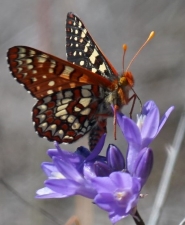 Choose A Site & Prepare Your Soil
Choose A Site & Prepare Your Soil
- Choose a spacious site in full sun.
- Prepare your soil (or several very large pots), by removing all existing growth and debris. If your soil is clay, break it up with some compost or cactus soil (sold at nurseries).
- Water thoroughly to help seeds settle into the soil. Continue to water a few times a week, unless it rains, so they don’t dry out after germinating. Seeds should sprout in one to three weeks.
- After you plant your seeds, let the area ‘go natural’ by leaving the leaf litter on the ground. While many butterflies go into chrysalis on stems or other hard surfaces like branches, many others go into chrysalis in the debris. If you rake or blow it, you could accidentally kill or throw them away.
Avoid using pesticides anywhere in your garden, it will kill the beneficial insects such as bees, butterflies, moths, and ladybugs that you are trying to attract. Try to ignore bugs, as they are part of the ecosystem (for instance, hummingbirds eat aphids). If you hose the plant or try to remove pests you may dislodge butterfly or ladybug eggs or kill tiny caterpillars. Avoid using herbicides as they also poison the ecosystem you are trying to nurture.
Plants In The California Pollinator Seed Mix
- Yarrow, Achillea millefolium (hosts Northern Scurfy Quaker, Olive Arches, Yarrow Plume Moth, Smeathmann's Aethes Moth)
- Mountain Garland, Clarkia unguiculata (hosts Clark's Day Sphinx Moth)
- Fort Miller Clarkia, Clarkia williamsonii (hosts Clark's Day Sphinx Moth, White-lined Sphinx, Pacific Green Sphinx Moth, Mariposa Forester)
- California Poppy, Eschscholzia californica (useful to pollinators, hosts Acmon Blue, Dotted Blue, Mormon Metalmark, etc.)Lupinus micrantha densiflorus himes crop small
Central Valley Gumplant, Grindelia camporum (hosts Orange Tortrix Moth, Cremastobombycia grindeliella)
- Dense-flowered Lupine, Lupinus microcarpus var. densiflorus (hosts Painted Lady, Acmon Blue, Boisduval's Blue, Silvery BLue, Orange Sulphur)
- Rock Phacelia, Phacelia californica (hosts Oidaematophorus phaceliae, Clepsis fucana, Bilobed Looper Moth, Orange Tortrix Moth)
- Great Valley Phacelia, Phacelia ciliata (hosts Bilobed Looper Moth, Orange Tortrix Moth, Geranium Plumed Moth)
- Bolander's Phacelia, Phacelia bolanderi (hosts Bilobed Looper Moth, Orange Tortrix Moth, Geranium Plumed Moth)
- Serpentine Sunflower, Helianthus bolanderi (hosts Painted Lady, Milbert's Tortoiseshell, California Patch)
The list of moths and butterflies hosted by these plants is just a sample, these plants are a host to many more - a comprehensive list of butterflies each plant hosts, and details about the plants and butterflies, can be found at Calscape.org
*”Host” = key food source for the caterpillars of these particular butterflies, that co-evolved to specialize over thousands of years. Butterflies die out without these plants.
Seed Packet Information: California Shady Wildflower Mix
California Shady Wildflower Mix
We hope you enjoy your seeds from the CNPS SCV Wildflower Ambassadors program. This plant mix is designed to provide flowers over a period of three months in the spring and early summer in a shady area.
Planting Instructions
Fall through winter is the ideal time to start growing California native wildflowers as these have adapted to capitalize on the fall and winter rains (October-February is best) and bloom in spring. They may be planted through April, but after that it is best to wait until at least September to plant them as they do not do well when planted in late spring or summer.
 Choose A Site & Prepare Your Soil
Choose A Site & Prepare Your Soil
- Choose a spacious site in full sun.
- Prepare your soil (or several very large pots), by removing all existing growth and debris. If your soil is clay, break it up with some compost or cactus soil (sold at nurseries).
- Water thoroughly to help seeds settle into the soil. Continue to water a few times a week, unless it rains, so they don’t dry out after germinating. Seeds should sprout in one to three weeks.
- After you plant your seeds, let the area ‘go natural’ by leaving the leaf litter on the ground. While many butterflies go into chrysalis on stems or other hard surfaces like branches, many others go into chrysalis in the debris. If you rake or blow it, you could accidentally kill or throw them away.
Avoid using pesticides anywhere in your garden, it will kill the beneficial insects such as bees, butterflies, moths, and ladybugs that you are trying to attract. Try to ignore bugs, as they are part of the ecosystem (for instance, hummingbirds eat aphids). If you hose the plant or try to remove pests you may dislodge butterfly or ladybug eggs or kill tiny caterpillars. Avoid using herbicides as they also poison the ecosystem you are trying to nurture.
Plants In The California Shady Wildflower Mix
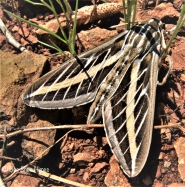
- Mountain Garland, Clarkia unguiculata (hosts Clark's Day Sphinx Moth)
- Chinese Houses, Collinsia heterophylla (hosts Variable Checkerspot)
- Baby Blue-Eyes, Nemophila menziesii (hosts Owlet Moth)
- Five Spot, Nemophila maculate (hosts Alfalfa Looper Moth)
- Farewell to Spring, Clarkia amoena (hosts White Lined Sphinx Moth)
- Punchbowl Godetia, Clarkia bottae (hosts Mariposa Forester)
- Bird’s Eye Gilia, Gilia tricolor (hosts Spotted Sun Straw Moth)
- Grand Linanthus, Linanthus grandifloras (hosts Buckwheat Borer Moth)
The list of moths and butterflies hosted by these plants is just a sample, these plants are a host to many more - a comprehensive list of butterflies each plant hosts, and details about the plants and butterflies, can be found at Calscape.org
*”Host” = key food source for the caterpillars of these particular butterflies, that co-evolved to specialize over thousands of years. Butterflies die out without these plants.
Wildflower Seed Planting
Grow Wildflowers!
 CNPS Santa Clara Valley Chapter is promoting biodiversiity by giving free wildflower seeds to native plant gardeners in our chapter area (Santa Clara and San Mateo counties) to re-energize the ecosystem in their home gardens. Together, we can bring back butterflies, bees, and birds. Find our Wildflower Ambassadors at events to receive free seeds.
CNPS Santa Clara Valley Chapter is promoting biodiversiity by giving free wildflower seeds to native plant gardeners in our chapter area (Santa Clara and San Mateo counties) to re-energize the ecosystem in their home gardens. Together, we can bring back butterflies, bees, and birds. Find our Wildflower Ambassadors at events to receive free seeds.
 Each seed packet you receive from us contains California native wildflowers in rich hues of gold, orange, pink, purple and blue that will cover three to four square feet or several large pots. You can scatter these seeds in an area planted with native grasses for a meadow effect.
Each seed packet you receive from us contains California native wildflowers in rich hues of gold, orange, pink, purple and blue that will cover three to four square feet or several large pots. You can scatter these seeds in an area planted with native grasses for a meadow effect.
Scattering a packet of native wildflower seeds is a joyful way to restore lost essential habitat while enhancing your gardening experience. We hope you revel in the beauty of the flowers, colorful caterpillars, variety of pollinators, baby birds, and the dance of life in your garden.
Planting Instructions
- Choose a site in full sun to partial shade.
- Prepare your soil by removing all existing growth and debris. If your soil is clay, break it up with some compost or cactus mix (sold at nurseries).
- Scatter your seeds over the prepared area. For more even coverage, you can mix your seeds with a little sand before scattering them.
- Water thoroughly to help seeds settle into the soil. Continue to water a few times a week, unless it rains, so they don’t dry out after germinating. Seeds should sprout in one to three weeks.
- After your plants are several inches tall, let the area ‘go natural’ by leaving the leaf litter on the ground. While many butterflies go into chrysalis on stems or other hard surfaces like branches, many others go into chrysalis in the debris. If you rake or blow it, you could accidentally kill or throw them away.
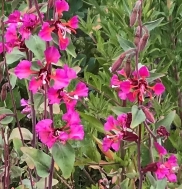 The beauty, color, and scent of flowers bring us joy. However, it's crucial to remember that for bees, butterflies, and birds, flowers serve as a vital source of nourishment for their survival. Plants and flowers provide bees with pollen, butterflies and moths with nectar, and caterpillars with essential food in the form of leaves. Butterflies, for instance, sip nectar from various flowers but lay their eggs exclusively on certain host plants that will nourish their offspring. The Variable Checkerspot, Silvery Blue, and other butterflies and moths depend on these plants as a food source for their caterpillars. In turn, these caterpillars play a crucial role in the survival of local birds, as 96% of the birds that visit your yard rely on caterpillars to feed their young. To learn more about this fascinating relationship, consider reading Nature's Best Hope by Doug Tallamy or watching this video. Share this information with your friends and neighbors. Some neighborhoods are even creating "butterfly corridors" by planting patches of wildflowers and native plants in their gardens. So, take a moment to appreciate the beauty and importance of flowers in our ecosystem.
The beauty, color, and scent of flowers bring us joy. However, it's crucial to remember that for bees, butterflies, and birds, flowers serve as a vital source of nourishment for their survival. Plants and flowers provide bees with pollen, butterflies and moths with nectar, and caterpillars with essential food in the form of leaves. Butterflies, for instance, sip nectar from various flowers but lay their eggs exclusively on certain host plants that will nourish their offspring. The Variable Checkerspot, Silvery Blue, and other butterflies and moths depend on these plants as a food source for their caterpillars. In turn, these caterpillars play a crucial role in the survival of local birds, as 96% of the birds that visit your yard rely on caterpillars to feed their young. To learn more about this fascinating relationship, consider reading Nature's Best Hope by Doug Tallamy or watching this video. Share this information with your friends and neighbors. Some neighborhoods are even creating "butterfly corridors" by planting patches of wildflowers and native plants in their gardens. So, take a moment to appreciate the beauty and importance of flowers in our ecosystem.
Want more seeds? Check our list of places to buy native seeds.
Contact us with questions at: This email address is being protected from spambots. You need JavaScript enabled to view it.
Resources for Gardeners
The California Native Plant Society (CNPS) is a science-based organization founded in 1965 with a mission to conserve California native plants and their natural habitats, and increase understanding, appreciation, and horticultural use of native plants. The Santa Clara Valley chapter covers Santa Clara County and southern San Mateo County. Check out the great resources on our website and the numerous talks on native plant gardening and native plant science on our YouTube channel. We also have chapter fieldtrips, online plant sales, and other exciting events like our annual Growing Natives Garden tour. The CNPS state website also has excellent resources and information to get you started with native plant science or gardening.
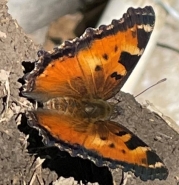 Want to find more California Native plants specific to your area, and the butterflies that use them as host plants? Then check out the wonderful CNPS Calscape website, which includes descriptions and planting information about every California native plant and links to native plant nurseries all over the state. For a user guide to using this amazing resource, watch this talk.
Want to find more California Native plants specific to your area, and the butterflies that use them as host plants? Then check out the wonderful CNPS Calscape website, which includes descriptions and planting information about every California native plant and links to native plant nurseries all over the state. For a user guide to using this amazing resource, watch this talk.
Discover flora and fauna in your region and across the globe, and even post your own observations on the iNaturalist app.
Seek answers to questions:
Why should we grow native plants to save birds and butterflies? Listen to Susan Karasoff here.
How can you restore nature in your garden? Dennis Mudd shares his insights
Where can you find more information about pollinator plants? Juanita Salisbury is an expert who talks about this.
When should you plant, water, prune, or leave things alone? Helen Popper shares a month-by-month guide for California gardeners.
What planting methods and soil will ensure success? Haven Kiers from UC Davis shares some research.
Need Plants? Find nurseries and plant sales using our list.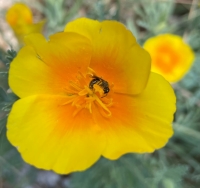
Seeking a few more butterfly resources? The Xerces Society is a great resource as well as the Bay Area Wildlife resource website.
Looking for a list of great books for gardening with native plants and ifor wildlife? Go to our resource page for books.
Need help getting started with a native plant garden? Tips are available in this video
Want to see most of California’s native habitats in one location? Check out the Regional Botanic Garden in Tilden Park.
Here is a list of public gardens with native plants.
Field Trip! Chapter field trips are listed here or on our Meetup page.
Contact us with questions at: This email address is being protected from spambots. You need JavaScript enabled to view it.

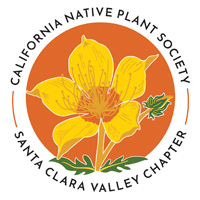

 Choose A Site & Prepare Your Soil
Choose A Site & Prepare Your Soil
 CNPS Santa Clara Valley Chapter is promoting biodiversiity by giving free wildflower seeds to native plant gardeners in our chapter area (Santa Clara and San Mateo counties) to re-energize the ecosystem in their home gardens. Together, we can bring back butterflies, bees, and birds. Find our Wildflower Ambassadors at
CNPS Santa Clara Valley Chapter is promoting biodiversiity by giving free wildflower seeds to native plant gardeners in our chapter area (Santa Clara and San Mateo counties) to re-energize the ecosystem in their home gardens. Together, we can bring back butterflies, bees, and birds. Find our Wildflower Ambassadors at  Each seed packet you receive from us contains California native wildflowers in rich hues of gold, orange, pink, purple and blue that will cover three to four square feet or several large pots. You can scatter these seeds in an area planted with native grasses for a meadow effect.
Each seed packet you receive from us contains California native wildflowers in rich hues of gold, orange, pink, purple and blue that will cover three to four square feet or several large pots. You can scatter these seeds in an area planted with native grasses for a meadow effect.  The beauty, color, and scent of flowers bring us joy. However, it's crucial to remember that for bees, butterflies, and birds, flowers serve as a vital source of nourishment for their survival. Plants and flowers provide bees with pollen, butterflies and moths with nectar, and caterpillars with essential food in the form of leaves. Butterflies, for instance, sip nectar from various flowers but lay their eggs exclusively on certain host plants that will nourish their offspring. The Variable Checkerspot, Silvery Blue, and other butterflies and moths depend on these plants as a food source for their caterpillars. In turn, these caterpillars play a crucial role in the survival of local birds, as 96% of the birds that visit your yard rely on caterpillars to feed their young. To learn more about this fascinating relationship, consider reading
The beauty, color, and scent of flowers bring us joy. However, it's crucial to remember that for bees, butterflies, and birds, flowers serve as a vital source of nourishment for their survival. Plants and flowers provide bees with pollen, butterflies and moths with nectar, and caterpillars with essential food in the form of leaves. Butterflies, for instance, sip nectar from various flowers but lay their eggs exclusively on certain host plants that will nourish their offspring. The Variable Checkerspot, Silvery Blue, and other butterflies and moths depend on these plants as a food source for their caterpillars. In turn, these caterpillars play a crucial role in the survival of local birds, as 96% of the birds that visit your yard rely on caterpillars to feed their young. To learn more about this fascinating relationship, consider reading  Want to find more California Native plants specific to your area, and the butterflies that use them as host plants? Then check out the wonderful CNPS
Want to find more California Native plants specific to your area, and the butterflies that use them as host plants? Then check out the wonderful CNPS 